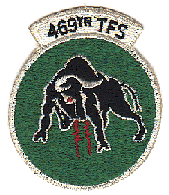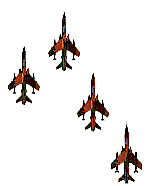
469th Tactical Fighter Squadron "Fighting Bulls"
Korat RTAFB, Thailand 8 November 1965 - 18 November 1968
Tail code: JV

The 469th TFS was transferred from the 355th Tactical Fighter Wing at McConnell AFB, Kansas, to the 6234th TFW at Korat RTAFB on 8 November 1965, and a few days later all of its pilots had arrived. The squadron started flying combat missions on 15 November 1965. Already on the second day of flying combat missions, the 469th lost its first pilot, Captain Donald G. Green (KIA). Sadly, the Fighting Bulls would suffer heavy losses throughout Rolling Thunder. Of all the Thunderchief squadrons that fought the Vietnam Air War, only the 354th TFS out of Takhli had a higher loss rate.
Besides destroying numerous ground targets in north Vietnam, the 469th also killed two MiG-17's in aerial combat. The following are two narratives copied without permission from the book "Aces and Aerial Victories":
4 December 1966, Major Roy S. Dickey:
"...The final MiG kill of 1966 was made by a 469th TFS pilot,
Major Roy S. Dickey on 4 December of that year. His flight was one
of several in a second wave fragged to strike a railroad yard
approximately 2 miles north of Hanoi. As the flight rolled in on
the target, the Thunderchiefs sighted four MiG-17s directly over
the target, several thousand feet below their flight level.
As Major Dickey came off his bomb run, he saw one of the MiGs at his 2
o'clock position, and he began to fire his 20mm gun as he closed to
within 700 feet. He ceased firing when the MiG burst into flames at
the wing roots. The entire fuselage behind the cockpit was a sheet
of flame. The MiG rolled over on its right wing and began spinning.
Major Dickey last saw the MiG in a flat right-hand spin at 3,500 feet.
Meanwhile, another MiG had begun to fire at Major Dickey from the
Thunderchief's 6 o'clock position. Major Dickey took evasive action and
after entering a steep dive, leveled off at 50 feet, and lost sight of
the second MiG..."
3 June 1967, Captain Larry D. Wiggins:
"...On the following day, F-105 pilots of the 388th TFW flying a strike mission
against the Bac Giang railroad and highway bridge and adjacent railroad
yards, did produce confirmed air-to-air victories by downing two MiG-17's.
Capt. Larry D. Wiggins, flying aircraft 3, and Maj. Ralph L. Kuster, Jr. (of
the 13th TFS) in position 2, each destroyed one of the enemy. They were in the
lead flight of a force of four strike and one Iron Hand flights launched from
Korat RTAFB, Thailand. Inbound to the target in a standard "pod" formation,
the four srtike flights penetrated the SAM defenses. When the F-105's were
about 15 miles short of the roll-in point, enemy 85-mm and 100-mm anti aircraft
artillery opened fire. During the dive-bomb run for flak suppression, Kuster fired
a short burst in an effort to obtain photography of the active AAA gun emplacements
adjacent to the target. He thus hoped to film the sites on the overrun of his gun
camera. The flight recovered from the dive-bomb run with Kuster trailing 1,500 feet
behind the lead, and Wiggins about a mile behind the flight leader.
Approximately 6 miles from the target the flight leader saw three MiG-17's at
10 o'clock low at a range of 2 miles. He called the MiG's position and started a
hard left turn. The second and third flight aircraft followed their leader, but
aircraft 4 nearly collided with the second flight off the target and lost his
flight in the turn. He elected to remain with the second flight during egress.
Initial maneuvering did not permit a firing pass, and the three MiG's went into a
tight left-hand orbit at about 500 feet altitude. The U.S. and enemy flights
completed a circle and a half before Wiggins was able to fire his AIM-9B at the
third MiG. The enemy plane attempted to evade the missile but was damaged.
Wiggins' film showed that the missile went alongside the MiG and exploded. The
aircraft began trailing a heavy white vapor. Continuing to close on the MiG as it
rolled over and started down, Wiggins fired 375 rounds of 20-mm at a high angle-off.
The MiG exploded in flame and crashed."
On 13 march 1968, the 469th TFS became the first F-105 unit to complete 30,000 combat flying hours, dropping approximately 135,000 tons of ordnance on North Vietnamese targets. By 30 October 1968, the 469th chalked up yet another impressive 10,000 combat hours in the 105.
All good things come to an end sooner or later, and around mid-November 1968, Thunderchief operations in the 469th TFS came to a close. The squadron prepared for its conversion to the F-4E Phantom II. Most, if not all, of the squadron members considered this a major downgrade, and as far as I know, all pilots, maintainers and jets went to the other Thunderchief squadrons at Korat and Takhli to finish their tours. However, before they left, the 469th TFS pilots made sure to slightly modify the unit insignia by adding a second eye to the bull's head (signifying the second aircrew member and two engines in the F-4) so that the new 469th Phantom crews would not be able to use the original "Fighting Bulls" patch.
In all, a damn fine squadron, which, sadly, no longer exists today.
